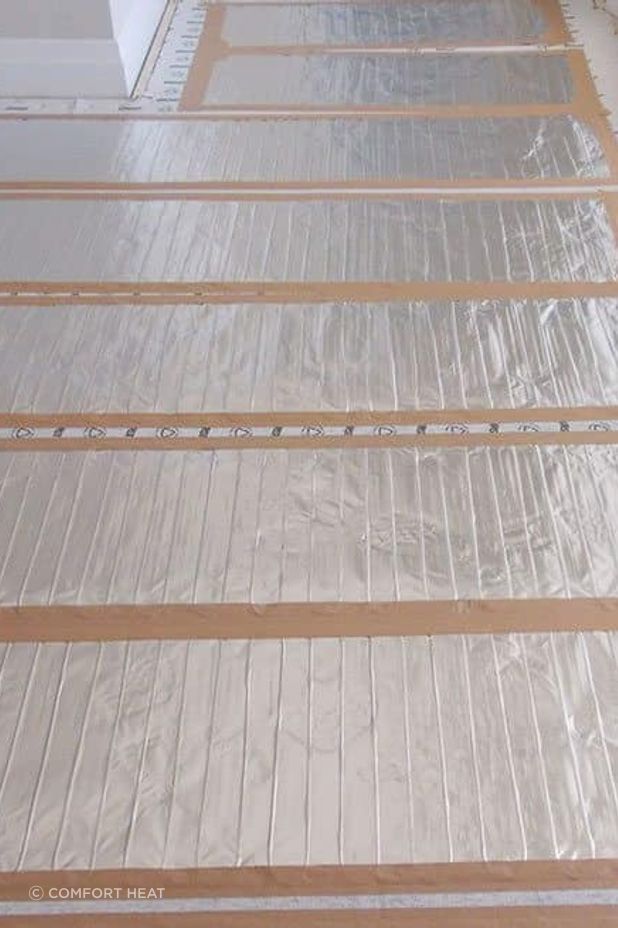A quick and easy guide to buying and installing underfloor heating systems
Written by
30 January 2023
•
5 min read
Gas and wood fireplaces, electric heaters and radiators are some of the most commonly used heating systems in Australia, but floor heating systems aren’t spoken about as often. Silent, efficient and allergy-friendly, floor heating systems feel divine underfoot while filling your home with gentle warmth. Sandra Skelly is the general manager at Comfort Heat, a leading Australian business that specialises in the design, supply and installation of both electric and hydronic floor heating systems, and she has some excellent advice for those looking to make the switch.
What is underfloor heating?
Underfloor heating systems are either electric cables or heated water in pipes that are installed in the slab, screed, ardit or tile glue of interior flooring. “These systems transfer heat to the surrounding floor, and as heat naturally rises to the surface it radiates into the room above, essentially turning the floor into a big radiator,” says Sandra. “Not only will the floor become warm to walk on, but the room will warm up as well.”
Floor heating systems can be installed into any room of the home, and are compatible with most types of flooring.“The best results are achieved with hard floors such as polished concrete, tiles and stone as the heat transfers through. Carpet is okay as long as it doesn’t have a rubberised backing,” says Sandra. “However, results with wood floors can be limited by the construction of the product, as some aren’t guaranteed for floor heating. Bamboo is never approved, and materials that act as insulators, such as cork or wool, stop the heat moving into the room.”
Read now: The high tech heating solution you've been looking for
What types of underfloor heating systems are available?
Floor heating systems can be electric or hydronic, and each is suitable for different purposes. “Electric floor heating can be installed into a slab, screed, a thin ardit or tile glue and directly under the carpet or floating timber floors. This type of floor heating is suitable for smaller areas and renovations,” says Sandra. “Hydronic heating systems require pipes within a slab, screed, or between battens for timber floor installation. The water in the pipes can be heated by a boiler fuelled by gas, wood, solar PV or electricity, and are suitable for larger areas, whole house heating or major renovations.”
When should underfloor heating systems be installed, and how much does it cost?
For best results, underfloor heating systems should be part of the initial design of the home so the required provisions and accommodations for the system can be incorporated into the house plans. “If the system is a last-minute decision then the options available to you could be more limited or expensive,” says Sandra.
The initial outlay and running costs of an underfloor heating system will depend on the size of the space you plan to service. A small bathroom could be fitted with a DIY system for just $400 and use as little as 170W, whereas a whole house can cost several thousand for installation, and operation costs may need to be subsidised with solar PV.
Read now: How to choose the best outdoor heating for your home
What are the benefits of underfloor heating?
One thing traditional gas, wood, electric and radiator heaters all have in common is that they produce high-temperature heat that relies on airflow for distribution within a space. As a result, much of the heat drifts towards the ceiling and can be negatively affected by the floorplan or furniture arrangement of a room. On the flip side, underfloor heating is a low-temperature and low-impact system that – when designed well – steadily and consistently provides comfortable heat at the ‘living’ level throughout your home. “Underfloor heating doesn’t require any mechanical parts to move the air around your home, ensuring silent operation, no dust or draughts,” says Sandra. “It’s totally invisible and doesn’t take up internal space, so there’s no impact on your interior design.”
How to pick the right underfloor heating system for your home
Accurate floor plans of the areas within your home you plan to heat are essential to obtaining an accurate system design and price quotation. “A professional floor heating company will be able to provide options and cost implications for a system that best suits your lifestyle and budget,” says Sandra. The supplier should also provide information and options for both electric and hydronic systems, so the correct model is proposed for each zone of your project.
Sandra also suggests requesting a running cost estimate for your proposed system, as it will provide you with a guide for the ongoing running costs you can expect to pay. “Most importantly, a good floor heating consultant will design a system that meets the customers' requirements and, when installed, performs better than they expected,” says Sandra.
Explore the range of products available from Comfort Heat on ArchiPro.

